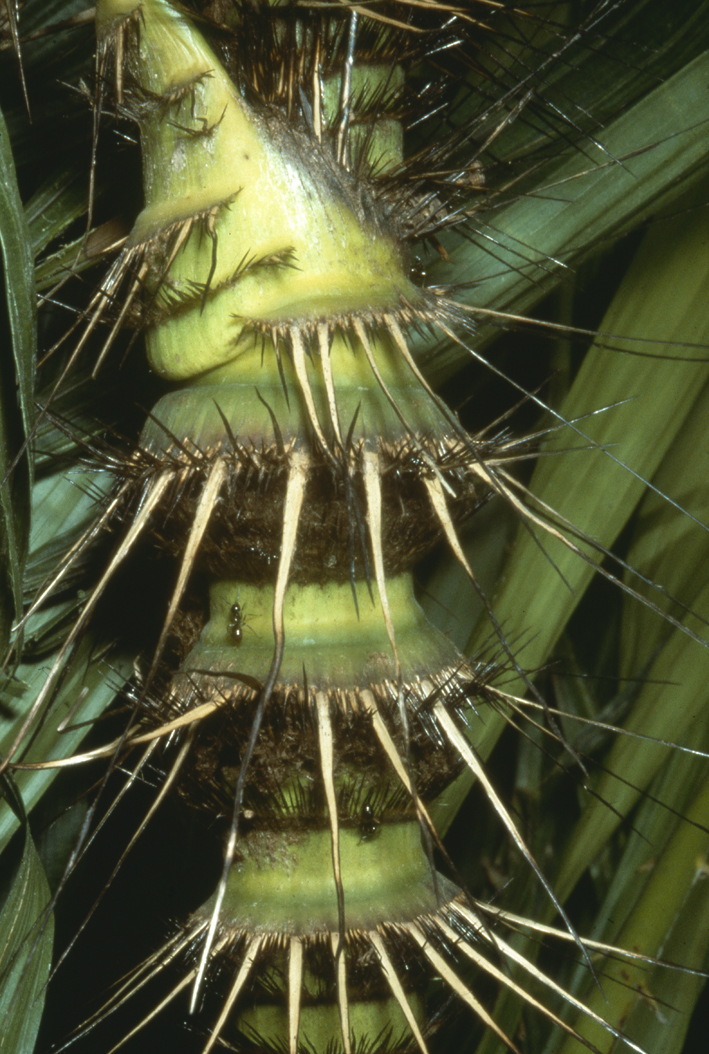- Acanthophoenix
- Acrocomia
- Actinokentia
- Actinorhytis
- Adonidia
- Aiphanes
- Allagoptera
- Ammandra
- Aphandra
- Archontophoenix
- Areca
- Arenga
- Asterogyne
- Astrocaryum
- Attalea
- Bactris
- Balaka
- Barcella
- Basselinia
- Beccariophoenix
- Bismarckia
- Borassodendron
- Borassus
- Brassiophoenix
- Burretiokentia
- Butia
- Calamus
- Calyptrocalyx
- Calyptrogyne
- Calyptronoma
- Carpentaria
- Carpoxylon
- Caryota
- Ceratolobus
- Ceroxylon
- Chamaedorea
- Chamaerops
- Chambeyronia
- Chelyocarpus
- Chuniophoenix
- Clinosperma
- Coccothrinax
- Cocos
- Corypha
- Cryosophila
- Cyphokentia
- Cyphophoenix
- Cyphosperma
- Deckenia
- Desmoncus
- Dictyocaryum
- Drymophloeus
- Dypsis
- Elaeis
- Eleiodoxa
- Eremospatha
- Eugeissona
- Euterpe
- Gaussia
- Geonoma
- Guihaia
- Hedyscepe
- Hemithrinax
- Howea
- Hyophorbe
- Hyospathe
- Hyphaene
- Iriartea
- Iriartella
- Itaya
- Jailoloa
- Johannesteijsmannia
- Juania
- Jubaea
- Jubaeopsis
- Kentiopsis
- Kerriodoxa
- Korthalsia
- Laccospadix
- Laccosperma
- Lanonia
- Latania
- Lemurophoenix
- Leopoldinia
- Lepidocaryum
- Lepidorrhachis
- Leucothrinax
- Licuala
- Linospadix
- Livistona
- Lodoicea
- Lytocaryum
- Manicaria
- Manjekia
- Marojejya
- Masoala
- Mauritia
- Mauritiella
- Maxburretia
- Medemia
- Metroxylon
- Myrialepis
- Nannorrhops
- Nenga
- Neonicholsonia
- Neoveitchia
- Nephrosperma
- Normanbya
- Nypa
- Oenocarpus
- Oncocalamus
- Oncosperma
- Orania
- Oraniopsis
- Parajubaea
- Pelagodoxa
- Phoenicophorium
- Phoenix
- Pholidocarpus
- Pholidostachys
- Physokentia
- Phytelephas
- Pigafetta
- Pinanga
- Plectocomia
- Plectocomiopsis
- Podococcus
- Pogonotium
- Ponapea
- Prestoea
- Pseudophoenix
- Ptychococcus
- Ptychosperma
- Raphia
- Ravenea
- Reinhardtia
- Retispatha
- Rhapidophyllum
- Rhapis
- Rhopalostylis
- Roscheria
- Roystonea
- Sabal
- Sabinaria
- Salacca
- Saribus
- Satakentia
- Satranala
- Schippia
- Sclerosperma
- Socratea
- Solfia
- Sommieria
- Syagrus
- Synechanthus
- Tahina
- Tectiphiala
- Thrinax
- Trachycarpus
- Trithrinax
- Veitchia
- Verschaffeltia
- Voanioala
- Wallaceodoxa
- Wallichia
- Welfia
- Wendlandiella
- Wettinia
- Wodyetia
- Zombia
- x Jubautia splendens
- ?? Acoelorrhaphe
- ?? Bentinckia
- ?? Brahea
- ?? Clinostigma
- ?? Colpothrinax
- ?? Copernicia
- ?? Cyrtostachys
- ?? Dictyosperma
- ?? Dransfieldia
- ?? Heterospathe
- ?? Hydriastele
- ?? Iguanura
- ?? Incertae sedis & excluded names
- ?? Loxococcus
- ?? Micronoma
- ?? Paripon
- ?? Pritchardia
- ?? Rhopaloblaste
- ?? Serenoa
- ?? Washingtonia

Distribution
Map uses TDWG level 3 distributions (https://github.com/tdwg/wgsrpd)
Widespread throughout Brunei. Elsewhere throughout Borneo and Peninsular Malaysia. (Dransfield, J. 1997: The Rattans of Brunei Darussalam)A
Discussion
- D. sabut is a frequent rattan usually found in moist soils in valley bottoms and lower hill slopes at altitudes up to c. 500 m above sea level. It and D. formicaria are the only species of Daemonorops in Brunei with complete interlocking collars forming ant galleries; D. formicaria is easily distinguished by the narrow linear close, regularly arranged leaflets. We have included three other names as synonyms of D. sabut; although the types of these names appeared to represent distinct species, we now have a range of specimens that are intermediate and we are unable to recognise more than one variable taxon. (Dransfield, J. 1997: The Rattans of Brunei Darussalam)A
Etymology
- From a local name (Dransfield, J. 1997: The Rattans of Brunei Darussalam)A
Common Name
- Wi Lepoh (Ib.) (Dransfield, J. 1997: The Rattans of Brunei Darussalam)A
Uses
- Produces a good quality cane. (Dransfield, J. 1997: The Rattans of Brunei Darussalam)A
Description
- Clustering moderate-sized rattan climbing to 40 m; stem without sheaths c. 15 mm diam., with sheaths to 30 mm diam., internodes to 15 cm long. Sheaths bright green, bearing complete and partial collars to 10 mm, tipped with black and brown horse-hair-like spines, 1-6 cm long, the longesttending to be paler in colour and all bearing abundant dark grey, caducous indumentum, at least some of the collars interlocking to produce ant galleries; knee conspicuous, usually less heavily armed than the sheath. Leaf cirrate, to 2.5 m long including the petiole to 40 cm and the cirrus to 1 m; petiole armed near the base with low collars bearing black spines, distally with scattered or grouped triangular spines; leaflets very variable in arrangement, to c. 20 on each side of the rachis, rarely subregular, usually grouped in 3’s to 6’s, the basal 2 groups being congested and the leaflets pointing in several directions, the longest usually the most basal, to 40 × 2.5 cm, unarmed except for short marginal bristles. Inflorescences pendulous, to 60 cm long, primary bracts densely armed with fine black spines, all except the prophyll quickly falling at anthesis, other bracts inconspicuous. Mature fruit ovoid, very shortly beaked, c. 16 × 12 mm, rarely spherical, covered with 14-17 vertical rows of yellowish-brown scales. Seed c. 12 × 9 mm; endosperm deeply ruminate. Seedling leaf with divergent leaflets. (Fig. 23, Pl. 4B). (Dransfield, J. 1997: The Rattans of Brunei Darussalam)A
Materials Examined
- BEL: Melilas, Sg.Ingei, Wong 637. TUT: Johns 7600; Lamunin, Kpg.Lamunin, Wong 66; Rambai, Bt.Bahak, Coode 7037. (Dransfield, J. 1997: The Rattans of Brunei Darussalam)A
- Log in to post comments

